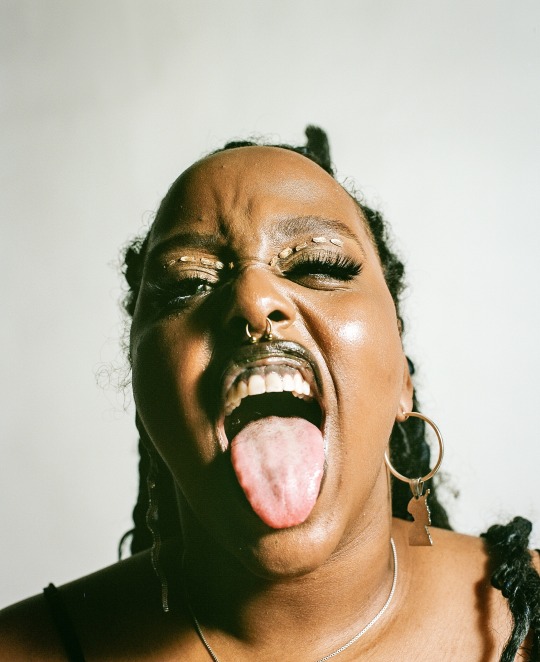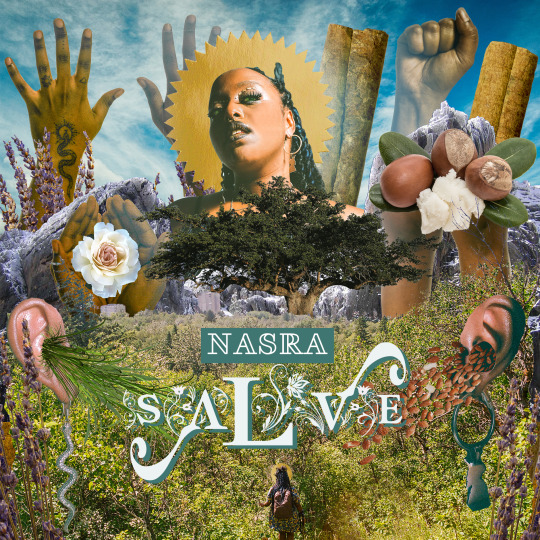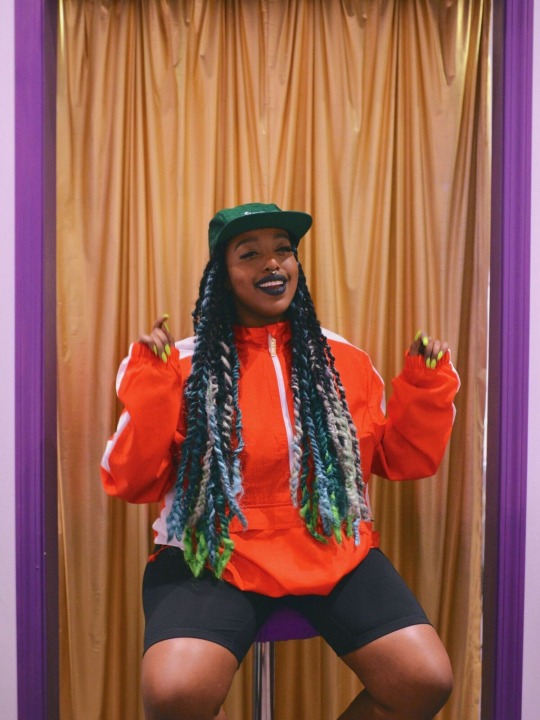#yegpoetry

Photo credit: Jibril Yassin
Art has always been their medicine. It’s where they go to fill up, create, innovate, heal, and reimagine the world as they need it to be. And in a year that’s cried out for healing and reimagining, it’s no surprise this multidisciplinary artist replied with poetry, film, dance, music—and heart. Because no matter the form it takes, their artwork honours the spectrum of freedom for Black/Indigenous Peoples everywhere. This week’s “I Am YEG Arts” story belongs to NASRA.
Tell us about your relationship with Edmonton and how it’s influenced your path.
It has been a ride. I was born in Calgary, then was in Ottawa and Toronto back and forth until I was 11. So I’ve been in Edmonton since 2007. It’s been really formative—I owe a lot to this land—but I’ve also experienced more of the truth of who I am through fighting Edmonton and getting picked on by Edmonton for being who I am and wanting what I want for myself. So It’s definitely layered. But I am very grateful for the spirit of gathering that exists here. And I’m grateful for the underdog energy that it brings because I’ve come to a state where I do rep Edmonton, I rep Treaty 6, I rep Amiskwaciy. Whenever I go anywhere, it’s definitely because of that hidden magic that exists here—the power of people’s stories and creative energy that exists here. A lot of people don’t think that Edmonton has what it takes, and I love proving them wrong. So it’s a mixed bag.
You’re often described as a creative and an innovator. Why are both important to you and your work?
I guess, to me, they mean the same thing. In my imagination, they’re closer than they’re made out to be. I feel very connected to the identity of being a creative—maybe more so than an innovator—but I think that’s because creativity in my world has always meant innovation. It’s always meant creating something from nothing. It’s always meant manifesting and materializing what exists in my imagination and making that real around me. And whether that’s through a piece of music or a poem, I’ve always needed creativity because of how it innovates my life—how it could take my circumstances and reimagine the world that I’m craving in my heart whenever I feel like I want more. That’s what I feel like creativity is about.
You were named Youth Poet Laureate of Edmonton in 2016. What do you think it is about poetry that resonates so strongly with youth?
There’s no rules! I remember it was the one subject in school that was really based on my feelings, and my perspective, and my reality, and my truth. And it allowed us to go explore ideas that were often too lofty or that, especially as a young person, I didn’t have a right to speak about. You don’t have a right to speak about love, you don’t have a right to speak about trauma, and authority, and autonomy—you don’t have a right to speak about your dreams other than how they’re going to get you into the workforce.

SALVE Ep cover. Design by Kaz Mega. Photo credit: Jibril Yasssin
Tell us about your ep, Salve.
Salve is my baby. And, honestly, I’m glad Salve exists just because it exists. I said I wanted to make music, and I made music! For me, music is my oldest dream… It’s also a collection of teachings that I’ve gathered around healing myself and a practical self-care that goes beyond bubble baths.
How would you describe Salve in terms of its style or influences?
I’m still trying to figure out what the style is myself, but it definitely pulls from a mixture of neo-soul and hip-hop, alongside a lot of base. The base is where I like to start, so it’s definitely base driven. And it’s a collection of spoken word along with music, and every song is about, and works with, the healing property of a certain herb because through herbal medicine, I’m connecting back to my African/Indigenous practices of healing. A huge part of what that album is about is how they have healed me through my practice with them.
Is there a piece of advice that you lean on when days are tough? What is it, and who offered it to you?
My mom, who is amazing, has always told me a variation of that phrase, “you are in the world, but not of it.” She’d also pair it with “don’t let this world take you.” As a child who was always very feely, and as a neurodivergent person and very sensitive human being, it is very often that some of my deepest pains and troubled times have come from just being overwhelmed by the pain I was experiencing—or just feeling by proxy. So, yeah, “don’t let the world take you. You are in it, but not of it.”
What does community mean to you, and where do you find it?
Wherever the love is. Yeah, wherever the values meet and the embodiment of those values meet—that’s where I find community. I am rooted in the belief that we are all connected, and I move through the world with that at the forefront. It’s how I was raised. I know that my values are pretty clear, and if I can align with folks on those values, and if the way they’re embodying them excites me and makes me curious and want to learn, I am all in. Let’s go!
Looking back on Black Art Matters (BAM), what’s one big thing it’s taught you about yourself and the arts community?
It’s taught me that I have to get real good at asking for help. It’s taught me boundaries—definitely. Again, I’m very dreamy and very feely, so I do have a lot of insight and ideas about how we can make things different—and different for me. That’s also at the forefront. A lot of this change is for me. I’m not out here for charity. I need the world to be nicer to me—to allow me to become who I am without trying to disappear me. I have a right to that. With BAM, I really grounded in the truth that If this isn’t serving me, it’s failed. And when I was experiencing burnout, I really needed to take that into account.
The chorus of the first song on Salveis: I’m the Black life that I’m fighting for / I’m the Black life that I’m living for / I’m the Black life that I’m loving for / I’m the Black life that I’m speaking for. It’s me, and I can’t create anything from me if it’s not also going to feed back into me. If it’s not going to pour back into me, there’s no use in that whatsoever. So I think that is a huge lesson that BAM has taught me: that I am the community that I am creating for. If that means I need to reel things in, or get more people to help, or take a nap for a year, I’ll do it.
I’m also living under and through multiple intersections that are actively being marginalized and systemically hunted and threatened. So I actually don’t have the privilege to just try something else. I have to figure it out and be the one who is the most responsible and in charge of my wellbeing. I have to call on my community to engage with the structures that it has set up for me and maybe change some of them so that I’m not working so hard just to choose myself every day when a lot of other people aren’t experiencing that much pushback. It’s not fair. I want to be fair to myself and call on my support systems to advocate for that care for me as well.
Which part of your creativity is unlocked when you collaborate?
I think the play gets activated for me, and I’m back in the sandbox when I get to collaborate. There’s always a perspective that I didn’t have access to, then all of a sudden it’s, ‘I didn’t even think about it like that because it wasn’t my job to, and now there’s a whole new world of possibility that we can access!’ When I collaborate, I also get to share the win. That’s my favourite part. It’s really nourishing, and it feeds me to then be able to go and be alone because I’ve been filled up.
Collaboration also activates my practices around vulnerability, and being wrong, and my ego… All of those things are valuable, even if I don’t feel like it at the time! They challenge me in those new perspectives. The play also opens you up to needing to let go of some of your ideas, and not experiencing them as precious little babies that you’ll never get back again. So that ego really has to soften and allow for that vision to be expanded. And even though it’s exciting, it can be uncomfortable as hell.
Is your starting place the same, regardless of whether you’re working alone or collaboratively?
Yeah. My starting point is always setting intentions and doing a bit of a needs assessment to see how big the “ask” is emotionally, mentally, physically, financially, spiritually. It’s me asking, ‘What am I expecting of myself and also from the folks that I’m working with, so that we can start from a place that is truly transparent?’

DNAPLAY by NASRA. Photo credit: Jibril Yasssin
Tell us a little about what you’re currently working on.
DNAPLAYis a multidisciplinary theatre piece that explores the routine as ritual. Coming from this quarantine experience and COVID experience, I’ve been called in along with my creative comrades to really venerate the tiny moments that actually aren’t so tiny when you look at the patterns that they belong to. And by looking at those patterns as ritual and as ceremony, I can give them the kind of sacred recognition they deserve because they’re what’s keeping me here. With this opportunity to slow down and take stock, I really wanted to remind myself that this is about who I am, not what I do. It’s about how can I really see the art in my every day and honour it so that I never feel like I’m not an artist—no matter what my paycheque or calendar is saying.
Salve is also going to be a backbone of the show. There’s going to be poetry, and film, and movement as the primary mediums that I’m channeling through. I’m very excited, and I’m working with a brilliant group of Black queer artists.
What makes you hopeful these days?
Oh, man. Definitely so much, but hope is where I live for the most part. But definitely the creativity of Black queer artists—and Black-Indigenous artists, and Indigenous artists across the board—is really feeding me. Communities that are on the frontlines in all shapes and forms, and who have a vision and are tapped in every day to innovation, and change, and imagination also give me hope. Looking back at history has always sustained and has a really great track record, so I’m really invested in Black imagination and Indigenous imagination for what could be possible for our lives and spirits.
You visit Edmonton 20 years from now. What do you hope has changed? What do you hope has stayed the same?
No more pipelines anywhere. I hope that people have homes, and that we have a really beautiful system of making sure people are living with dignity. And that there is a thriving, culturally diverse, and brilliant arts scene that has room for everyone to speak their peace.
Want more YEG Arts Stories? We’ll be sharing them here all year and on social media using the hashtag #IamYegArts. Follow along! Click here to learn more about NASRA, Salve, and DNAPLAY.

Photo credit: Emily Welz
About NASRA
NASRA is a queer Oromo/Somali multidisciplinary artist based in Amiskwaciywaskahikan (Edmonton). Everything NASRA creates stems from the Black Indigenous belief that art is nature expressing itself; a true language of languages that has and will continue to sustain Black life. This belief named them Youth Poet Laureate of Edmonton in 2016 and birthed their festival turned platform, Black Arts Matter. BAM celebrates the inherent worth of Black creatives in Alberta through performance, education, and paaaaaarties.
NASRA’s currently exploring their creative languages through DNAPLAY; a veneration of Black queer routine as ritual. Channeled through poetry, film, dance, and the genre-bending, bass-driven sounds of their ep, Salve. No matter the form it takes, NASRA’s heartwork honours the spectrum of freedom for Black/Indigenous Peoples everywhere.
